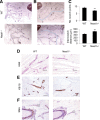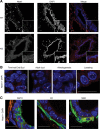The long noncoding RNA Neat1 is required for mammary gland development and lactation
- PMID: 25316907
- PMCID: PMC4238351
- DOI: 10.1261/rna.047332.114
The long noncoding RNA Neat1 is required for mammary gland development and lactation
Abstract
The lncRNA Neat1 is an essential architectural component of paraspeckle nuclear bodies. Although cell-based studies identified Neat1-paraspeckles as key regulators of gene expression through retention of hyperdited mRNAs and/or transcription factors, it is unclear under which specific physiological conditions paraspeckles are formed in vivo and whether they have any biological relevance. Herein, we show that paraspeckles are assembled in luminal epithelial cells during mammary gland development. Importantly, genetic ablation of Neat1 results in aberrant mammary gland morphogenesis and lactation defects. We provide evidence that the lactation defect is caused by a decreased ability of Neat1-mutant cells to sustain high rates of proliferation during lobular-alveolar development. This study is the first to assign an important biological function to the lncRNA Neat1 and to link it to the presence of paraspeckles nuclear bodies in vivo.
Keywords: NEAT1; long noncoding RNA; mammary gland development; paraspeckles.
© 2014 Standaert et al.; Published by Cold Spring Harbor Laboratory Press for the RNA Society.
Figures



Similar articles
-
ALS-linked FUS mutations confer loss and gain of function in the nucleus by promoting excessive formation of dysfunctional paraspeckles.Acta Neuropathol Commun. 2019 Jan 14;7(1):7. doi: 10.1186/s40478-019-0658-x. Acta Neuropathol Commun. 2019. PMID: 30642400 Free PMC article.
-
NEAT1 modulates herpes simplex virus-1 replication by regulating viral gene transcription.Cell Mol Life Sci. 2017 Mar;74(6):1117-1131. doi: 10.1007/s00018-016-2398-4. Epub 2016 Oct 25. Cell Mol Life Sci. 2017. PMID: 27783096 Free PMC article.
-
An architectural role for a nuclear noncoding RNA: NEAT1 RNA is essential for the structure of paraspeckles.Mol Cell. 2009 Mar 27;33(6):717-26. doi: 10.1016/j.molcel.2009.01.026. Epub 2009 Feb 12. Mol Cell. 2009. PMID: 19217333 Free PMC article.
-
Molecular anatomy of the architectural NEAT1 noncoding RNA: The domains, interactors, and biogenesis pathway required to build phase-separated nuclear paraspeckles.Wiley Interdiscip Rev RNA. 2019 Nov;10(6):e1545. doi: 10.1002/wrna.1545. Epub 2019 May 1. Wiley Interdiscip Rev RNA. 2019. PMID: 31044562 Review.
-
Paraspeckles: nuclear bodies built on long noncoding RNA.J Cell Biol. 2009 Sep 7;186(5):637-44. doi: 10.1083/jcb.200906113. Epub 2009 Aug 31. J Cell Biol. 2009. PMID: 19720872 Free PMC article. Review.
Cited by
-
lncRNA Neat1 regulates neuronal dysfunction post-sepsis via stabilization of hemoglobin subunit beta.Mol Ther. 2022 Jul 6;30(7):2618-2632. doi: 10.1016/j.ymthe.2022.03.011. Epub 2022 Mar 21. Mol Ther. 2022. PMID: 35331906 Free PMC article.
-
Novel Insights into the Emerging Role of Neat1 and Its Effects Downstream in the Regulation of Inflammation.J Inflamm Res. 2022 Jan 26;15:557-571. doi: 10.2147/JIR.S338162. eCollection 2022. J Inflamm Res. 2022. PMID: 35115805 Free PMC article. Review.
-
Interplay of lncRNA H19/miR-675 and lncRNA NEAT1/miR-204 in breast cancer.Mol Oncol. 2019 May;13(5):1137-1149. doi: 10.1002/1878-0261.12472. Epub 2019 Mar 14. Mol Oncol. 2019. PMID: 30803129 Free PMC article.
-
Long non-coding RNAs: regulators of autophagy and potential biomarkers in therapy resistance and urological cancers.Front Pharmacol. 2024 Oct 24;15:1442227. doi: 10.3389/fphar.2024.1442227. eCollection 2024. Front Pharmacol. 2024. PMID: 39512820 Free PMC article. Review.
-
NEAT1-mediated regulation of proteostasis and mRNA localization impacts autophagy dysregulation in Rett syndrome.Nucleic Acids Res. 2025 Feb 8;53(4):gkaf074. doi: 10.1093/nar/gkaf074. Nucleic Acids Res. 2025. PMID: 39921568 Free PMC article.
References
-
- Fatica A, Bozzoni I 2014. Long non-coding RNAs: new players in cell differentiation and development. Nat Rev Genet 15: 7–21. - PubMed
Publication types
MeSH terms
Substances
LinkOut - more resources
Full Text Sources
Other Literature Sources
Molecular Biology Databases
